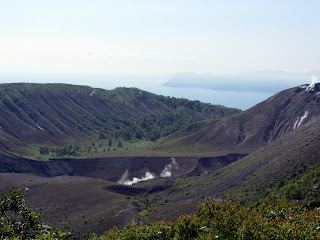We took a 1-day tour out of Sapporo to visit two caldera lakes, Lake Shikotsu and Lake Toya. The tour took us also to the crater of Mount Usu, which is a live volcano (!) although its last eruption was in 1977 (quite a spectacular one, as it turned out) and a view of Mount Yotei, a mini-Mount Fuji.
I do recommend these day tours for people who want to see the country side but don't want to have to work too much for it. The Chuo Bus tour we took left from the bus station just next to our hotel, was very informative, good value (includes lunch), and was very efficiently and well run (just what every good Singaporean wants). We had an "audio-lingual" tour, ie we had our own set of headphones and so could select the commentary in the language of our choice (English, Chinese, Korean, and of course Japanese). The commentary covered quite a bit of background on the development of Hokkaido as well as on the places we were visiting, the flora and fauna of the region, and even (when we were getting back to Sapporo) on Sapporo gourmet delights.
 |
| Lake Shikotsu and our glass bottomed-boat |
 |
| Columns on the floor of Lake Shikotsu |
We travelled first to Lake Shikotsu, where we took a boat ride in a glass-bottomed boat from which we could view the lake floor. The water is amazingly clear at the sides, although it did get slightly more murky the further out we got from the shore. What was fascinating was that there were these columns appearing at the base of the lake. The explanation was that this was caused by volcanic activity in the past, when caverns formed by magma collapsed, leaving the columns. The crater eventually filled with water, creating the lake. The lake itself is quite deep in the middle, so much so that it does not freeze even in the depths of the Hokkaido winter. You can read more about Lake Shikotsu in this good
write-up I've found on the Lake and surrounding mountains.
Our next stop would be at a little rest stop where (accordingly to the commentary) the locals were famous for their mushrooms. So we had a yummy bowl of mushroom miso soup, tonnes of mushrooms within for the princely sum of 100Y!!! A good deal indeed.
 |
| Two of the four cute little islands of Lake Toya |
We went to
Lake Toya next - this is another caldera lake, but with four cute little islands in the middle! No, we did not visit the islands. Unfortunately for us. But it was nonetheless an interesting visit, and we spent some time by the lakeside enjoying the scenery.
Lake Toya is clearly more developed and accessible than Lake Shikotsu - there's a few decent sized hotels here - I an see this place being very popular for say conferences or corporate retreats (if the Japanese have such things that is).
We had lunch here. It was a pretty good lunch, lots of veggies, but also a hamburger and a panko-encrusted prawn.
 |
| Mount Usu crater |
Next stop -
Mount Usu, an active volcano which last erupted in 2000-2001. It was great fun, as we went up a ropeway to the top of the mountain and then saw the volcano crater. Apparently there is a walk which takes you much closer to the crater's edge but we did not go there....
The mountain actually overlooks Lake Toya, so we had beautiful views of the lake from this vantage point, next to the little volcano Mount Showa Shinzan.
Mount Showa Shinzan came up by itself in the middle of a farmer's field between 28 Dec 1943 and Sep 1945 as a result of volcanic activity in the region.
 |
| Lake Toya with Mount Showa Shinzan |
Mount Yotei was the last mountain we came close to on our tour. Japan has a number of mountains which they call "mini mount Fujis", so called because of the regular symmetrical shape of its slopes. Mount Yotei is one of them. We did not visit it per se but we viewed it from Lake Toya and also drove near it. We saw it from various points and this was one of the last photos taken - by this time, it was getting darker, so it looks rather moody from my photo.









